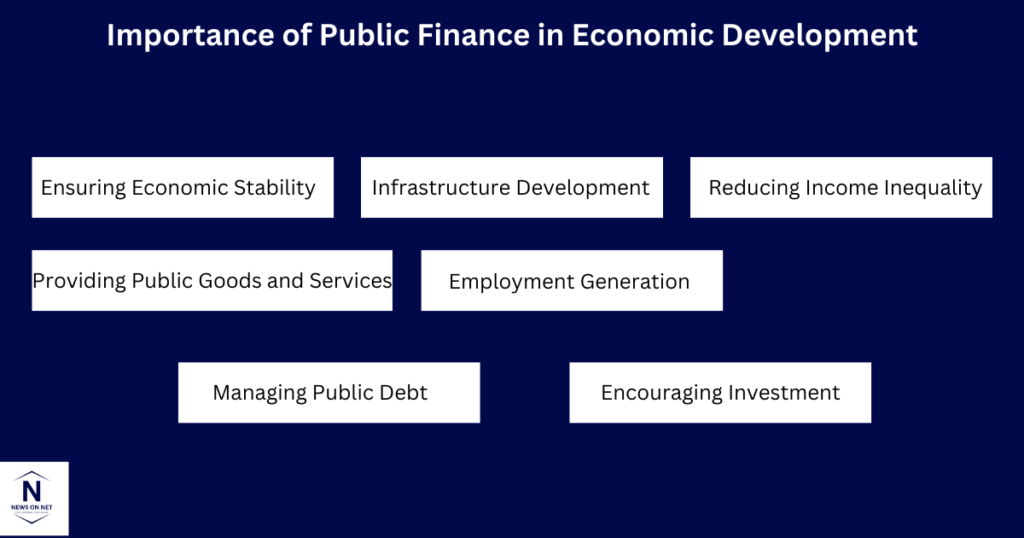Public finance is all about how governments manage their money. It includes collecting taxes, spending money on public services, and handling debt. Public finance ensures that governments have the resources they need to improve people’s lives, support the economy, and create a fair society. By understanding public finance, we can see how governments prioritize their spending and manage financial challenges.
Components of Public Finance
Let’s break down the key parts of public finance to understand how governments handle their finances:
Tax Collection
Taxes are the main way governments earn money. They collect taxes from individuals, businesses, and even on products and services. This money is used to pay for public services like schools, hospitals, and roads. Common types of taxes include income tax, sales tax, property tax, and corporate tax. A good tax system makes sure the money is collected fairly and efficiently.
Governments may also introduce tax incentives to encourage investments in certain areas like renewable energy or small businesses. While taxes are necessary for public funding, ensuring a fair tax structure is key to maintaining public trust and economic balance.
Budget
A government’s budget is its plan for how to earn and spend money over a year. It shows what the government’s priorities are, like funding education, healthcare, or building infrastructure. Budgets can be balanced (income equals spending), surplus (income is more than spending), or deficit (spending is more than income).
The budgeting process involves setting goals, estimating revenue, and deciding on expenditures. For example, a government might allocate more funds to healthcare during a pandemic. Budgets are not just financial documents; they are reflections of a government’s vision and policy priorities.
Expenditures
Government spending is called expenditures. It includes paying for services, building projects, and investments. Some spending is for long-term projects, like highways or schools, while other spending covers day-to-day costs, like employee salaries or subsidies. Proper planning of expenditures ensures resources are used wisely.
Expenditures are broadly classified into two categories: capital and revenue. Capital expenditures are investments that create long-term assets, while revenue expenditures cover operational costs. Both types play a crucial role in economic development and maintaining public services.
Deficit/Surplus
A deficit happens when the government spends more money than it earns, leading to borrowing. A surplus means the government has more income than expenses, which can be used to save or pay off debt. Managing these is crucial to keeping the economy healthy.
Deficits are not always bad. For example, borrowing to fund infrastructure projects can boost economic growth. However, consistent deficits can lead to higher national debt and interest payments, limiting future spending flexibility.
National Debt
National debt is the total amount of money a government owes. It’s created by borrowing to cover deficits over time. While some debt can help fund growth and development, too much debt can lead to financial problems in the future.
Governments borrow money through bonds, loans, or international organizations. Managing national debt involves finding the right balance between borrowing for growth and keeping repayment obligations under control. High debt levels can affect a country’s credit rating and economic stability.
ALSO READ: What Is Personal Finance Meaning, Importance & Tips
Managing Public Finance
Good public finance management is essential for a strong economy. Governments use strategies like adjusting taxes or spending (fiscal policies) to control the economy. For instance, during an economic slowdown, a government might lower taxes or increase spending to stimulate growth.
Transparency and accountability are also important so people can trust that public funds are being used effectively. Governments often publish reports and audits to show how money is spent. International organizations like the IMF and World Bank also guide countries in managing their public finances.
Revenue and Expenditures
Revenue is the money a government earns, mostly from taxes, but also from fees, fines, and grants. Expenditures are how the government spends this money on things like healthcare, education, and defense. Balancing revenue and spending is key to avoiding debt and meeting public needs.
Governments face the challenge of matching limited revenues with unlimited public demands. Prioritizing essential services and cutting unnecessary expenditures can help maintain fiscal balance. Additionally, revenue diversification—such as investing in public enterprises or tourism—can reduce dependency on taxes alone.
MUST READ: Top Stock Market Movies and Web Series: Lessons and Inspiration
Key Components of Public Finance
-
Public Revenue – Includes taxes, duties, fines, and government earnings.
-
Public Expenditure – Government spending on defense, education, healthcare, infrastructure, and welfare.
-
Public Debt – Borrowing by the government to meet financial shortfalls.
-
Fiscal Policy – Strategies to control inflation, unemployment, and economic stability.
-
Financial Administration – Managing and monitoring public resources efficiently.
Types of Public Finance
Public finance is broadly classified into the following types:
1. Public Revenue
This includes all the income generated by the government from different sources such as taxes, fees, and fines.
-
Tax Revenue: Includes direct and indirect taxes such as income tax, corporate tax, sales tax, and customs duties.
-
Non-Tax Revenue: Comprises earnings from government services, fines, penalties, and interest on loans.
2. Public Expenditure
Public expenditure refers to government spending on various sectors. It is divided into:
-
Developmental Expenditure: Investments in infrastructure, healthcare, education, and research.
-
Non-Developmental Expenditure: Spending on defense, administration, and interest payments on public debt.
3. Public Debt
When government spending exceeds revenue, it borrows money domestically and internationally. Public debt is classified into:
-
Internal Debt: Borrowings from within the country, such as bonds and treasury bills.
-
External Debt: Loans from international institutions like the World Bank and IMF.
4. Fiscal Policy
This involves government strategies to regulate economic activities through taxation and spending. There are two types:
-
Expansionary Fiscal Policy: Used to boost economic growth through increased government spending and tax cuts.
-
Contractionary Fiscal Policy: Implemented to control inflation by reducing spending and increasing taxes.
Importance of Public Finance
Public finance plays a crucial role in shaping a nation’s economic stability, social welfare, and overall development. It is the foundation of government policies that influence the allocation of resources, taxation, public spending, and debt management. Without effective public finance, governments would struggle to provide essential services, maintain infrastructure, and support economic growth.
In this article, we will explore the importance of public finance, its various components, types, challenges, and its impact on economic and social progress. We will also include real-life examples and case studies to provide a comprehensive understanding of the subject.
Importance of Public Finance in Economic Development
Public finance is the backbone of a nation’s economy. Governments use financial resources to drive economic progress by funding essential sectors and ensuring stability. Here are some key areas where public finance is indispensable:

1. Ensuring Economic Stability
Public finance helps stabilize the economy by managing inflation, unemployment, and economic recessions. Through fiscal policies, governments can increase public spending during economic downturns and control excess liquidity during inflationary periods.
Example: The U.S. government implemented stimulus packages during the 2008 financial crisis and the COVID-19 pandemic to boost economic recovery.
2. Infrastructure Development
Public finance supports the development of roads, bridges, railways, airports, and other critical infrastructure. Without government investment, many large-scale projects would be unfeasible for private entities to undertake.
Case Study: China’s Belt and Road Initiative (BRI) is a prime example of large-scale public financing in infrastructure, improving global trade connectivity.
3. Reducing Income Inequality
Through taxation and welfare programs, public finance redistributes wealth, ensuring that basic needs such as healthcare, education, and social security are accessible to all citizens, particularly the underprivileged.
4. Providing Public Goods and Services
Public finance ensures that essential services like education, healthcare, sanitation, and security are available to everyone. These services contribute to overall well-being and improve quality of life.
5. Employment Generation
Government-funded projects in infrastructure, healthcare, and education create millions of jobs, directly and indirectly contributing to the economy’s growth.
6. Managing Public Debt
Public finance plays a crucial role in controlling national debt and ensuring sustainable economic growth. Proper debt management prevents financial crises and improves investor confidence.
7. Encouraging Investment
Governments use financial policies to create a favorable investment climate by offering incentives, subsidies, and tax breaks to businesses and entrepreneurs, driving economic growth.
Challenges in Public Finance
While public finance is essential, it faces several challenges that governments must address to ensure effective financial management:
-
Corruption and Mismanagement – Improper allocation and misuse of funds can hinder development.
-
Tax Evasion – A major issue that reduces government revenue and weakens the economy.
-
Public Debt Burden – Excessive borrowing can lead to financial crises.
-
Inflation Control – Balancing economic growth with inflation management is a constant challenge.
-
Global Economic Conditions – Economic instability in other countries can affect national financial policies.
Global Perspectives on Public Finance
Different countries manage public finance in diverse ways based on their economic size, resources, and policies. Developed countries often have advanced systems for tax collection and budget management, while developing nations may rely on external aid or loans. Learning from successful public finance models can help improve financial management worldwide.
For instance, Nordic countries are known for their high tax rates and extensive social benefits, ensuring economic equality and public welfare. Meanwhile, countries like Singapore focus on maintaining low debt and investing heavily in infrastructure and education.
Conclusion
The importance of public finance cannot be overstated, as it is the driving force behind a nation’s economic and social progress. From funding infrastructure and creating jobs to reducing poverty and ensuring sustainability, public finance impacts every aspect of life.
For a country to thrive, its financial resources must be managed wisely, ensuring transparency, accountability, and efficiency. A strong public finance system not only ensures national development but also paves the way for a more equitable and prosperous society.
FAQs
1. Why is public finance important? I
t helps governments provide essential services, boost the economy, and ensure everyone has access to public benefits like education and healthcare.
2. What are the main sources of public finance?
Governments earn money from taxes, fees, fines, grants, and public sector businesses.
3. How do governments handle a budget deficit?
They borrow money, cut spending, or increase taxes to cover the gap.
4. How does public finance support economic growth?
It funds critical areas like infrastructure, education, and public services, helping to create jobs and improve living standards.
5. What’s the difference between national debt and a budget deficit?
A deficit is when spending exceeds income in one year. National debt is the total amount borrowed over time to cover deficits.
6. How does public finance affect citizens?
It impacts the quality of public services, tax rates, and the overall economy, influencing everyone’s daily life.
7. Can high national debt harm a country?
Yes, excessive debt can lead to higher taxes, reduced public services, and economic instability if not managed well.
8. Why is public finance important?
Public finance is essential for economic stability, infrastructure development, social welfare, and income redistribution. It helps governments manage resources efficiently and ensure sustainable growth.
9. What are the main sources of public revenue?
The primary sources of public revenue include tax revenue (income tax, corporate tax, sales tax) and non-tax revenue (fees, fines, interest on loans, and government service charges).
10. How does public finance affect economic growth?
Public finance influences economic growth by funding infrastructure, reducing unemployment, stabilizing inflation, and encouraging investments through tax incentives and subsidies.
11. What are the challenges in managing public finance?
Challenges include corruption, tax evasion, excessive public debt, inflation control, and fluctuating global economic conditions.
12. How does public finance reduce income inequality?
Through progressive taxation, social welfare programs, and public investments in healthcare and education, public finance helps bridge the wealth gap and support underprivileged communities.
13. What is the role of fiscal policy in public finance?
Fiscal policy is a key tool in public finance that regulates government revenue and expenditures to maintain economic stability, control inflation, and promote growth.
14. How does public debt impact a country’s economy?
While borrowing helps fund projects and stimulate growth, excessive public debt can lead to financial crises, high interest payments, and reduced investor confidence.
Riyo is a Digital Marketing expert with specialization in SEO and Market Analysis. He has hands-on experience in keyword research, on-page & off-page SEO, and data-driven marketing strategies. Riyo helps businesses boost their online visibility and grow through smart digital tactics.


